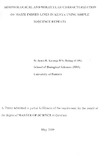| dc.description.abstract | Maize (Zea mays L.) is the mam staple food in Kenya with ninety percent of the
population depending on it for food and income. Despite its importance, farmers in
Kenya harvest less than 2.0 ton/ha compared to world average of 5tonlha. The low
productivity is as result of many factors that relate to on farm production constraints and
insufficient knowledge on the genetic source of germplasm used for crop improvement.
The main objective of this study was to characterize ten elite maize inbred lines using
fourteen simple sequence repeats (SSRs) molecular markers and morphological traits in
order to better understand germplasm diversity. The field experiment was carried out at
Kenya Agricultural Research Institute (KARl) field station at Muguga (2093 meters
above sea level). Maize for morphological characterization were planted using thc
randomized complete block design and grown for one season. Molecular analysis was
carried out using genomic DNA extracted from three weeks old leaves using the modified
Cetyltrimethyl-ammonium bromide (CTAB) method at KARl Biotechnology center
Nairobi. In total 28 alleles were identified, with a mean of 2.0 alleles per locus. Cluster
analysis of morphological traits and SSR markers using unweighted pair group method
with arithmetic average (UPGMA) revealed three groups among the inbred lines with
distinctive genetic profiles and morphological traits. The phenotypic analysis revealed
significant variation with respect to plant and ear height, time to anthesis and silk
emergence (50%), anthocyanin coloration and yield. Both morphological and molecular
analysis showed that CML206, CML204 and CML312 are related. Likewise CML202
and CML444 clustered together in both analyses. CML395 and CML 442 were also
grouped together in both morphological and molecular analysis. The two KARl lines
(EMll-133 and EMI2-2IO) were grouped together suggesting a common ancestry.
Molecular analysis showed that the line OSU23i is genetically related to the lines EM 11-
133 and EMI2-2IO. However, morphological analysis classified OSU23i as unique as it
did not cluster with any inbred line. Both molecular and morphological traits were
necessary in grouping the ten maize inbred lines. The SSR primers revealed genetic
distance «0.3), which is, a good indication confirming the power of SSR markers to
distinguish between closely related inbred lines.
As a result of this study breeders will be able to select putative heterotic parents for
hybridization and stratify the breeding programs based on the diverse characterization of
the inbred lines such as EM 11-133 and CML 204, EM 12-210 and CML 395 and CML
202 and CML 204 with a genetic distance of 1.54. On the other hand breeders should
avoid crossing lines which are closely related such as CML 206 and CML 312, EM 11-
133 and CML 395 and CML 444 and CML 442 with genetic distance of 0.154. It will
also help in designing sound breeding program and improve management strategy for the
ten elite maize lines. | en |

